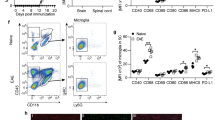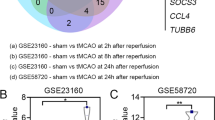Abstract
Excessive activation of pro-inflammatory (M1) microglia phenotypes after spinal cord injury (SCI) disrupts tissue repair and increases the risk of secondary SCI. We previously reported that adeno-associated virus (AAV) mediated delivery of bone morphogenetic protein 7 (BMP7) promotes functional recovery after SCI by reducing oligodendrocyte loss and demyelination; however, little is known about the early effects of BMP7 in ameliorating neuroinflammation in the acute SCI phase. Herein, we demonstrate that treatment with recombinant human BMP7 (rhBMP7) suppresses the viability of LPS-induced HMC3 microglia cells and increases the proportion with the M2 phenotype. Consistently, in a rat SCI model, rhBMP7 decreases the activation of microglia and promotes M2 polarization. After rhBMP7 administration, the STAT3 signaling pathway was activated in LPS-induced HMC3 cells and microglia in spinal cord lesions. Furthermore, the levels of TNF-α and IL-1β were significantly decreased in cell culture supernatants, lesion sites of injured spinal cords, and cerebrospinal fluid circulation after rhBMP7 administration, thus reducing neuron loss in the injured spinal cord and promoting functional recovery after SCI. These results provide insight into the immediate early mechanisms by which BMP7 may ameliorate the inflammation response to secondary SCI.








Similar content being viewed by others
Data Availability
The data and materials that support the findings of this study are available from the corresponding author, Yaping Wang, upon reasonable request.
References
Anjum A et al (2020) Spinal cord injury: pathophysiology, multimolecular interactions, and underlying recovery mechanisms. Int J Mol Sci. https://doi.org/10.3390/ijms21207533
Brockie S, Hong J, Fehlings MG (2021) The role of microglia in modulating neuroinflammation after spinal cord injury. Int J Mol Sci. https://doi.org/10.3390/ijms22189706
Hassanzadeh S et al (2021) More attention on glial cells to have better recovery after spinal cord injury. Biochem Biophys Rep 25:100905. https://doi.org/10.1016/j.bbrep.2020.100905
Wang X, Xu JM, Wang YP, Yang L, Li ZJ (2016) Protective effects of BMP-7 against tumor necrosis factor alpha-induced oligodendrocyte apoptosis. Int J Dev Neurosci 53:10–17. https://doi.org/10.1016/j.ijdevneu.2016.04.011
Liu S et al (2021) Overexpression of bone morphogenetic protein 7 reduces oligodendrocytes loss and promotes functional recovery after spinal cord injury. J Cell Mol Med 25:8764–8774. https://doi.org/10.1111/jcmm.16832
Kwon HS, Koh SH (2020) Neuroinflammation in neurodegenerative disorders: the roles of microglia and astrocytes. Transl Neurodegener 9:42. https://doi.org/10.1186/s40035-020-00221-2
Varghese F, Bukhari AB, Malhotra R, De A (2014) IHC Profiler: an open source plugin for the quantitative evaluation and automated scoring of immunohistochemistry images of human tissue samples. PLoS ONE 9:e96801. https://doi.org/10.1371/journal.pone.0096801
Nguyen NM et al (2022) Efonidipine Inhibits JNK and NF-kappaB Pathway to Attenuate Inflammation and Cell Migration Induced by Lipopolysaccharide in Microglial Cells. Biomol Ther (Seoul) 30:455–464. https://doi.org/10.4062/biomolther.2022.076
Aguzzi A, Barres BA, Bennett ML (2013) Microglia: scapegoat, saboteur, or something else? Science 339:156–161. https://doi.org/10.1126/science.1227901
Gerber YN et al (2018) CSF1R Inhibition Reduces Microglia Proliferation, Promotes Tissue Preservation and Improves Motor Recovery After Spinal Cord Injury. Front Cell Neurosci 12:368. https://doi.org/10.3389/fncel.2018.00368
Wang W et al (2017) Methane Suppresses Microglial Activation Related to Oxidative, Inflammatory, and Apoptotic Injury during Spinal Cord Injury in Rats. Oxid Med Cell Longev 2017:2190897. https://doi.org/10.1155/2017/2190897
Lv R et al (2019) Polydatin alleviates traumatic spinal cord injury by reducing microglial inflammation via regulation of iNOS and NLRP3 inflammasome pathway. Int Immunopharmacol 70:28–36. https://doi.org/10.1016/j.intimp.2019.02.006
Tsai M-J et al (2007) Dual effect of adenovirus-mediated transfer of BMP7 in mixed neuron-glial cultures: Neuroprotection and cellular differentiation. J Neurosci Res 85:2950–2959. https://doi.org/10.1002/jnr.21395
Bellver-Landete V et al (2019) Microglia are an essential component of the neuroprotective scar that forms after spinal cord injury. Nat Commun 10:518. https://doi.org/10.1038/s41467-019-08446-0
Brennan FH et al (2022) Microglia coordinate cellular interactions during spinal cord repair in mice. Nat Commun 13:4096. https://doi.org/10.1038/s41467-022-31797-0
Fu H et al (2020) Depletion of microglia exacerbates injury and impairs function recovery after spinal cord injury in mice. Cell Death Dis 11:528. https://doi.org/10.1038/s41419-020-2733-4
Wang C et al (2018) Salidroside attenuates neuroinflammation and improves functional recovery after spinal cord injury through microglia polarization regulation. J Cell Mol Med 22:1148–1166. https://doi.org/10.1111/jcmm.13368
Akhmetzyanova E, Kletenkov K, Mukhamedshina Y, Rizvanov A (2019) Different Approaches to Modulation of Microglia Phenotypes After Spinal Cord Injury. Front Syst Neurosci 13:37. https://doi.org/10.3389/fnsys.2019.00037
Jiang CT, Wu WF, Deng YH, Ge JW (2020) Modulators of microglia activation and polarization in ischemic stroke (Review). Mol Med Rep 21:2006–2018. https://doi.org/10.3892/mmr.2020.11003
Li YF, Ren X, Zhang L, Wang YH, Chen T (2022) Microglial polarization in TBI: Signaling pathways and influencing pharmaceuticals. Front Aging Neurosci 14:901117. https://doi.org/10.3389/fnagi.2022.901117
Castro LVG, Goncalves-de-Albuquerque CF, Silva AR (2022) Polarization of Microglia and Its Therapeutic Potential in Sepsis. Int J Mol Sci. https://doi.org/10.3390/ijms23094925
Dziennis S, Alkayed NJ (2008) Role of signal transducer and activator of transcription 3 in neuronal survival and regeneration. Rev Neurosci 19:341–361. https://doi.org/10.1515/revneuro.2008.19.4-5.341
Zhong Y et al (2022) JAK2/STAT3 Axis Intermediates Microglia/Macrophage Polarization During Cerebral Ischemia/Reperfusion Injury. Neuroscience 496:119–128. https://doi.org/10.1016/j.neuroscience.2022.05.016
Liu ZJ et al (2019) Melatonin protects against ischemic stroke by modulating microglia/macrophage polarization toward anti-inflammatory phenotype through STAT3 pathway. CNS Neurosci Ther 25:1353–1362. https://doi.org/10.1111/cns.13261
Yang L, Liu S, Wang Y (2019) Role of bone morphogenetic protein-2/4 in astrocyte activation in neuropathic pain. Mol Pain 15:1744806919892100. https://doi.org/10.1177/1744806919892100
Rajan P, Panchision DM, Newell LF, McKay RDG (2003) BMPs signal alternately through a SMAD or FRAP–STAT pathway to regulate fate choice in CNS stem cells. J Cell Biol 161:911–921. https://doi.org/10.1083/jcb.200211021
Yu D et al (2022) Inhibition of STAT3 signaling pathway by terphenyllin suppresses growth and metastasis of gastric cancer. Front Pharmacol 13:870367. https://doi.org/10.3389/fphar.2022.870367
Jo S et al (2021) STAT3 phosphorylation inhibition for treating inflammation and new bone formation in ankylosing spondylitis. Rheumatology (Oxford) 60:3923–3935. https://doi.org/10.1093/rheumatology/keaa846
Le Dreau G et al (2012) Canonical BMP7 activity is required for the generation of discrete neuronal populations in the dorsal spinal cord. Development 139:259–268. https://doi.org/10.1242/dev.074948
Ortega JA, Alcantara S (2010) BDNF/MAPK/ERK-induced BMP7 expression in the developing cerebral cortex induces premature radial glia differentiation and impairs neuronal migration. Cereb Cortex 20:2132–2144. https://doi.org/10.1093/cercor/bhp275
Bragdon B et al (2011) Bone morphogenetic proteins: a critical review. Cell Signal 23:609–620. https://doi.org/10.1016/j.cellsig.2010.10.003
Pei H et al (2013) Bone morphogenetic protein-7 ameliorates cerebral ischemia and reperfusion injury via inhibiting oxidative stress and neuronal apoptosis. Int J Mol Sci 14:23441–23453. https://doi.org/10.3390/ijms141223441
Tsai MJ et al (2010) Adenoviral gene transfer of bone morphogenetic protein-7 enhances functional recovery after sciatic nerve injury in rats. Gene Ther 17:1214–1224. https://doi.org/10.1038/gt.2010.72
Elmadbouh I, Singla DK (2021) BMP-7 attenuates inflammation-induced pyroptosis and improves cardiac repair in diabetic cardiomyopathy. Cells. https://doi.org/10.3390/cells10102640
Aluganti Narasimhulu C, Singla DK (2020) the role of bone morphogenetic protein 7 (BMP-7) in inflammation in heart diseases. Cells. https://doi.org/10.3390/cells9020280
Stumm CL et al (2014) Lung remodeling in a mouse model of asthma involves a balance between TGF-beta1 and BMP-7. PLoS ONE 9:e95959. https://doi.org/10.1371/journal.pone.0095959
Chen C, Bai GC, Jin HL, Lei K, Li KX (2018) Local injection of bone morphogenetic protein 7 promotes neuronal regeneration and motor function recovery after acute spinal cord injury. Neural Regen Res 13:1054–1060. https://doi.org/10.4103/1673-5374.233449
Acknowledgements
We thank LetPub (www.letpub.com) for linguistic assistance and pre-submission expert review and the support from the Natural Science Foundation of Hunan Province (Grant Numbers: 2020JJ4811).
Funding
The Natural Science Foundation of Hunan Province, 2020JJ4811, The Key Research and Development Program of Hunan Province, 2020SK2097.
Author information
Authors and Affiliations
Contributions
WY and WX conceived the idea; WX and HC conducted the analyses and interpreted the results; all authors contributed to the writing and revisions.
Corresponding author
Ethics declarations
Conflict of interest
The authors have no conflict of interest to declare.
Additional information
Publisher's Note
Springer Nature remains neutral with regard to jurisdictional claims in published maps and institutional affiliations.
Supplementary Information
Below is the link to the electronic supplementary material.
Rights and permissions
Springer Nature or its licensor (e.g. a society or other partner) holds exclusive rights to this article under a publishing agreement with the author(s) or other rightsholder(s); author self-archiving of the accepted manuscript version of this article is solely governed by the terms of such publishing agreement and applicable law.
About this article
Cite this article
Wei, X., Huang, C., Chen, K. et al. BMP7 Attenuates Neuroinflammation after Spinal Cord Injury by Suppressing the Microglia Activation and Inducing Microglial Polarization Via the STAT3 Pathway. Neurochem Res 48, 2687–2700 (2023). https://doi.org/10.1007/s11064-023-03930-y
Received:
Revised:
Accepted:
Published:
Issue Date:
DOI: https://doi.org/10.1007/s11064-023-03930-y




